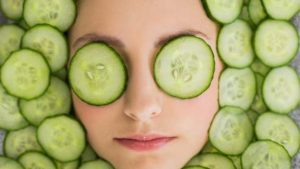Cucumbers found in retail markets are often waxed to improve visual appeal and retard moisture loss. This waxing may affect bacterial survival and the waxing process may facilitate cross-contamination between cucumbers. This study assessed survival of Salmonella on waxed and un-waxed cucumbers and the potential for Salmonella cross-contamination during the waxing process.
 Fresh waxed or un-waxed cucumbers were spot-inoculated with a Salmonella enterica cocktail. Three different wax coatings (mineral oil, vegetable oil, or petroleum wax) were manually applied to un-waxed cucumbers using polyethylene brushes. Salmonella transfer from inoculated cucumbers to brush or to un-inoculated cucumbers was quantified.
Fresh waxed or un-waxed cucumbers were spot-inoculated with a Salmonella enterica cocktail. Three different wax coatings (mineral oil, vegetable oil, or petroleum wax) were manually applied to un-waxed cucumbers using polyethylene brushes. Salmonella transfer from inoculated cucumbers to brush or to un-inoculated cucumbers was quantified.
Higher Salmonella concentrations were observed on waxed cucumbers during the first 3 days of storage but the final concentration on un-waxed cucumbers was higher than on waxed cucumbers at the end of storage, regardless of storage temperature. Wax formulation did affect survival of Salmonella inoculated directly into waxes, with the significant decline in Salmonella populations observed in vegetable-based wax coating, but with populations unchanged over 7 days at 7 or 21 °C in mineral oil-based and petroleum-based waxes. Salmonella cells could transfer from inoculated un-waxed cucumbers to brushes used for waxing and then to un-inoculated cucumbers during waxing. Significantly higher log percent transfer to brushes was observed when cucumbers were waxed with vegetable oil (0.71 log percent, P = 0.00441) vs. mineral oil (0.06 log percent) or petroleum (0.05 log percent).
Transfer to un-inoculated cucumbers via brushes was also quantified (0.18 to 0.35 log percent transfer). Salmonella remaining on contaminated cucumbers after waxing could be detected for up to 7 days, and Salmonella survived better on cucumbers treated with a petroleum-based wax. These findings should be useful in managing risk of Salmonella contamination in cucumbers during post-harvest handling.
Quantification of survival and transfer of salmonella on fresh cucumbers during waxingJournal of Food Protection
30 October 2020
Jiin Jung and Donald Schaffner

.jpg) 3 special steps, that’s all you need
3 special steps, that’s all you need The Hot Dog song on Mickey Mouse Clubhouse was written and performed by They Might Be Giants, and the Handy Manny theme song was written and performed by Los Lobos.
The Hot Dog song on Mickey Mouse Clubhouse was written and performed by They Might Be Giants, and the Handy Manny theme song was written and performed by Los Lobos.